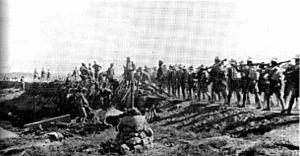Action of Khan Baghdadi facts for kids
Quick facts for kids Action of Khan Baghdadi |
|||||||
|---|---|---|---|---|---|---|---|
| Part of the Mesopotamian campaign of World War I | |||||||
 The 2nd Battalion, 6th Gurkha Rifles of 42nd Indian Brigade, 15th Indian Division march towards the action of Khan Baghdadi, 22 March 1918 |
|||||||
|
|||||||
| Belligerents | |||||||
| Commanders and leaders | |||||||
| Strength | |||||||
| 15th Indian Division(20,000) | 50th Infantry Division(12,000) | ||||||
| Casualties and losses | |||||||
| 1,590 | ~500 | ||||||
The Action of Khan Baghdadi was an important battle during the Mesopotamian campaign in World War I. It took place in March 1918 near the town of Khan al Baghdadi in what is now Iraq. This battle was a big win for the British forces against the Ottoman Empire.
Contents
What Happened at Khan Baghdadi?
Moving Towards the Battle
The 15th Indian Division was a group of soldiers from British India. They had been stationed at a town called Ramadi since September 1917. On March 9, 1918, they moved forward and took control of another town called Hit. The Ottoman forces left Hit without a fight, so no shots were fired.
A New Battle Plan
The next goal for the British was the town of Khan al Baghdadi. Most battles in this area happened along the Tigris and Euphrates rivers. Usually, if one side won, the losing side would just retreat along the river. This made it hard to get a complete victory.
To change this, the 15th Indian Division tried something new. They used 300 Ford trucks to move soldiers quickly. They also had armored cars and a group of cavalry (soldiers on horseback). This fast-moving group was called a "mobile blocking force."
Surprise Attack
This special mobile force did something clever. Instead of attacking from the front, they drove all the way around Khan Baghdadi. They then dug in behind the Ottoman positions.
Meanwhile, the rest of the British soldiers attacked the town from the front, as usual. The Ottoman forces started to retreat from Khan Baghdadi. But they were surprised when they ran right into the British blocking force waiting for them!
The Ottoman soldiers quickly lost their organization. About 5,000 of them were captured, which was a huge victory for the British.
Pushing Further
After this success, the mobile force kept going up the Euphrates River. They went 46 miles further to a place called Ana. This was a main supply base for the Ottoman army. The British captured it, along with some high-ranking German officers who were helping the Ottoman Army.
After the Battle
The Action of Khan Baghdadi was the last major attack on the Euphrates Front during this campaign. Later, many vehicles were sent to help another military group called Dunsterforce. Because of this, the main British commander in Mesopotamia, Sir William Marshall, decided to focus only on the Tigris Front.
When the war ended with the Armistice of Mudros on November 1, 1918, the 15th Indian Division was back downriver at Fallujah.

